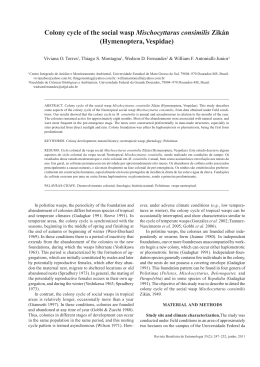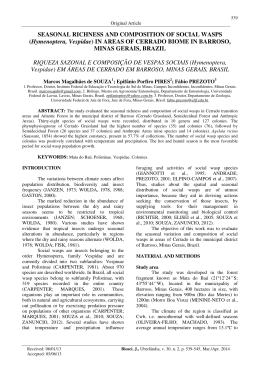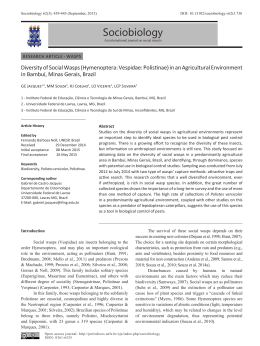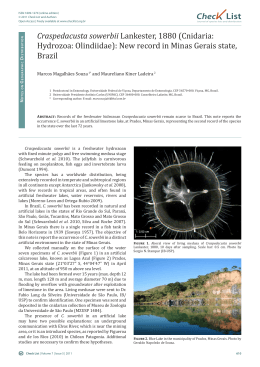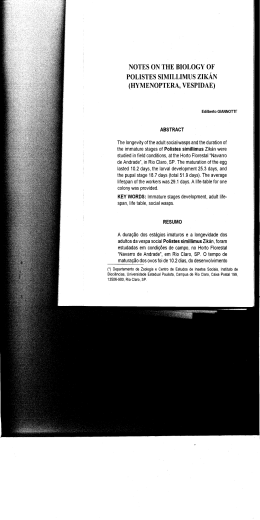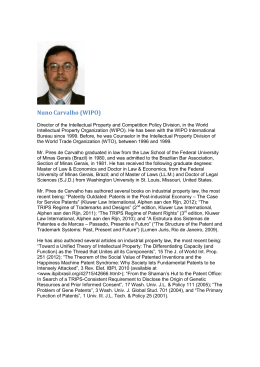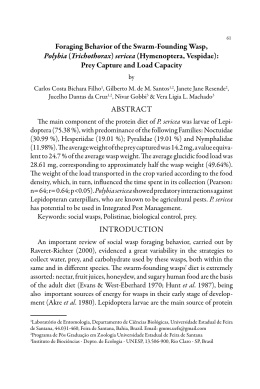Sociobiology 62(3): 450-456 (September, 2015) DOI: 10.13102/sociobiology.v62i3.708 Sociobiology An international journal on social insects RESEARCH ARTICLE - WASPS Use of flight interception traps of Malaise type and attractive traps for social wasps record (Vespidae: Polistinae) MM SouzA1, LN Perillo2, BC Barbosa3, F Prezoto3 1 - Instituto Federal de Educação, Ciência e Tecnologia do Sul de Minas, Minais Gerais, Brazil 2 - Bocaina Ciências Naturais e Educação Ambiental, Minas Gerais, Brazil 3 - Universidade Federal de Juiz de Fora, Juiz de Fora, Minas Gerais, Brazil Article History Edited by Gilberto M. M. Santos, UEFS, Brazil Received 18 November 2014 Initial acceptance 18 June 2015 Final acceptance 11 August 2015 Keywords Atlantic Rainforest, collection methodologies, diversity, inventory. Corresponding author Marcos Magalhães de Souza Instituto Federal de Educação, Ciência e Tecnologia do Sul de Minas Campus Inconfidentes Praça Tiradentes nº 416, Centro, 37576-000 Inconfidentes-MG, Brazil E-Mail: [email protected] Abstract The literature provides different methodologies for sampling social wasps, including, flight intercept trap type Malaise and Attractive trap, however, there is no consensus on its use. In this respect, the aim of this study was to evaluate the best use of Malaise traps and Attractive trap in biodiversity work of social wasps, and generate a collection protocol for the use of these traps. The study was conducted in the Parque Estadual do Rio Doce, located in the east of the state of Minas Gerais, in the years 2000, 2001, 2002 and 2004 and in the Botanical Garden of the Federal University of Juiz de Fora, located in the southeastern state of Minas Gerais, in years 2011, 2012 and 2013. 15 species were collected using Malaise traps, and, 26 species of social wasps were collected using Attractive traps. Although the negative aspects of both traps, complementary methodologies surveys varying social wasps are useful and it is recommended to choose for using in accordance with the logistical field. Introduction The scientific literature reports different colection methodologies applied on studies about social wasps biodiversity approaching several Brazilian biomes, such as Cerrado- the Brazilian savannah, rainforests, rupestrian fields, riparian forest, caatinga, as well as the areas with monoculture (Diniz & Kitayama, 1998; Souza & Prezoto, 2006; Santo et al., 2007; Silva & Silveira, 2009; Souza et al., 2010; Melo et al., 2015). The most used methods for capturing Polistinae are the active search. The use of attractive traps, flight interception traps of Malaise type and collection close to floral resources. Among these, the Malaise traps are among the methodologies most commonly used (Silveira, 2002; Kumar et al., 2009; Noll & Gomes, 2009; Somavilla & Oliveira, 2013) and so are the attractive traps (Souza & Prezoto, 2006; Elpino-Campos et al., 2007), even though they are less efficient than the active search for nests of social wasps (Silveira, 2002; Noll & Gomes, 2009). Authors have already presented data about the use and the efficiency of Malaise and Attractive Trap for recording social wasps, but there is not a defined pattern for using this methodology (Silveira, 2002; Silva & Silveira, 2009; Locher et al., 2014; Barbosa, 2015). The flight interception traps type Malaise (Townes, 1962; 1972) are applied for sampling different kinds of insects, besides social wasps, such as Diptera (Andrade-Filho et al., 2008), Coleoptera (Linzmeier et al., 2006) and different families of Hymenoptera with single habits (Tanque & Frieiro-Costa, 2011; Kumagaia, 2002). The Malaise trap, due to the possibility of exposition for long continuous periods in autonomous way (Andrade-Filho et al., 2008), are commonly used individually or in small amounts. However, there is not much data on the efficiency to sample the community of species in a small number of traps or the necessary time for them to be left on the field (Fraser et al., 2008). Open access journal: http://periodicos.uefs.br/ojs/index.php/sociobiology ISSN: 0361-6525 Sociobiology 62(3): 450-456 (September, 2015) The use of attractive traps to capture social wasps began in Brazil with the pioneer work of Lorenzato in 1985, which performed a study about the occurrence of such insects in apple and peach orchards in Caçador, Santa Catarina, Southern Brazil. In this study the author used three types of attractive substances (wine vinegar at 25%, brown sugar at 5% and grape juice at 25%), that were displayed in bottles which are used to catch flies, model Valenciano, with the result of 12 species of wasps – belonging to five genus – being captured. More than ten years later, Santos (1996) has also made use of attractive traps to collect social wasps in citrus orchards in a farm in the surroundings of Goiânia, Goiás, central region of Brazil. In this study, the author has used orange juice at 50% and sugar at 10% in units of 200ml in bottles that capture flies as attractive baits. After one year of collection, nine species of wasps, belonging to five genus, were reported. Ten years later, there was a resumption on the studies about diversity of social wasps using attractive traps, with the studies of Souza and Prezoto (2006) and Elpino-Campos et al. (2007), which were inspired on the previously quoted studies and modified and adapted the collection methodology. The authors started to use PET bottles as containers, in which different kinds of attractive substances were tested (sardine broth, orange juice, passion fruit and water with sugar). The goal of this work was to evaluate the advantages and disadvantages of using Malaise traps and Attractive Traps in studies of biodiversity of social wasps, as well as to generate a sampling protocol for the use of such traps. Materials and Methods Malaise Trap The study was conducted in Rio Doce State Park, eastern Minas Gerais (420 38’W - 480 28’W - 190 45’S - 190 30’S), Conservation Unit that hosts the biggest remainder of rainforest in the state, with 36,970 hectares. The climate is hot and wet, with two well-defined seasons: one of them is dry and cold (April to September), with temperatures ranging from 70 C to 200 C, and the other is wet and hot (October to march), with temperatures ranging from 280 C to 390 C. The average precipitation ranges between 1,350mm and 1,900mm and the heights vary from 236m to 515m (CETEC, 1983; Antunes, 1986). By using the Malaise trap, it was possible to sample Polistinae in three different successional stages, defined according to the Gilhuis classification (1986): low and high second-growth, as well as primary kinds of forest. In each place three spots were selected and, in each one of them, three Malaise traps were installed, coming up to nine traps by successional stage. They were simultaneously set in all the spots and each one was kept for three consecutive weeks in the field in each climate season. The collected materials were analyzed during the dry (July) and the wet (between October 451 and November) seasons of 200, 2001, 2002 and 2004, coming to four years of samples with more than 12,000 hours of traps for each spot. Attractive Traps The study was performed at the Botanical Garden of Federal University of Juiz de Fora (21° 43’ 28” S - 43°16’ 47” O),a fragment of Semideciduous Seasonal Montana Forest (IBGE, 2012), located in the urban area of Juiz de Fora, southeast region of Minas Gerais, 750m above the sea level, and presents subtropical hot climate with a dry winter and rainy summer (Cwa), according Köppen-Geiger (SáJúnior et al., 2012) classification. The area, with 84 hectares of extension, was recently classified by Santiago et al. (2014) as complex of expressive richness, diversity and floristic heterogeneity of tree vegetation, with some endangered species and with predominance of pioneer plants, aside the remarkable existence of exotic species, it is considered an urban green area (Marciel & Barbosa, 2015) The records of social wasps occurred from September /2011 to August/2013. The collections happened monthly with duration of five days, 32 bottles used for each collection; the traps were divided in two height levels: 1.5m from the ground and 10m from the ground, with the possibility of variation according to the local vegetation characteristics. The traps were evenly distributed in two areas. For each one, the distance between the spots was 10m. The attractive substances were natural passion fruit juice and natural guava juice. The traps were kept in the field for five days (summing up to 120 days of collection with traps), the screening of the material was performed in loco, using a strainer to make the separation of liquids and insects easier. After this, the insects were stored in glass containers (5ml) with alcohol 70°gl that were properly labeled. Results and Discussion With Malaise traps, 15 species of social wasps of five genus were collected, and the most frequent species were Agelaia angulata (Fabricius, 1804) and Agelaia centralis (Cameron, 1907). And for the Attractive Traps, 26 species of 10 different genus were collected, and the most frequent species were Agelaia multipicta (Haliday, 1836) e Polybia platycephala (Richards, 1951). Species of genus Agelaia are usually abundant in studies of diversity due to the great size of the colonies (Zucchi et al., 1995; Hunt et al., 2001). The greatest richness of species that was reported in this study for the Polybia genus corroborates with other data collections performed in other Brazilian regions (Diniz & Kitayama, 1994; Elpino-Campos et al., 2007; Silva & Silveira, 2009; Grandinete & Noll, 2013; Barbosa et al., 2014). This fact may be related to the number of species that make the group (57, 44 of which are recorded 452 MM SouzA, LN Perillo, BC Barbosa, F Prezoto – Standardizing two methods for social wasp sampling in Brazil), the abundance of members in each colony, and its distribuction, that goes from United States to Argentina, and it is considered the most frequent genre of social wasps in South America (Richards, 1978; Jeanne, 1991; Carpenter et al., 2000; Carpenter & Marques, 2001). This number species collected by Malaise trap in low, when compared with other studies in the same area usind active search as main sampling method for social wasps, as showed by Souza et al. (2012), where 38 species were reported during one year of collection with 20 days of sampling. All the species that were collected using Malaise were reported in the active search (Souza et al., 2012). This lower efficiency may be explained by the scope of operation of the social wasps, which is generally around 150 meters (Cruz et al., 2006), and restrain the efficiency of capture to the presence of colony close to the traps. Another point to be considered is that the traps keep set up in the same spot during all the experiment, reducing thus the chance of sampling members of other colonies of different species. Studies conducted in the Brazilian Amazon also showed this lower efficiency of Malaise traps, compared to the active search (Silveira, 2002; Silva & Silveira, 2009). Aiming to make this methodology a pattern, a description is shown above of the standard used in most of the works: The traps are built with a fine, lightweight and durable fabric – organza, nylon or bias are preferable – making an open tent, placed close to the ground, with a septum in the central area. If possible, make it with dark walls and light roof (Fig 1). This contrast between the colors and the bottom and top sections in essential to induce the insects to fly to the top, searching for the light while they are actually conducted the sampling container (Almeida et al., 1998). They can be assembled during all the study or be replaced to other areas, according to the logistics and the size of the sampled area. In wide areas, there must be used the most traps possible, located from 0.5 to 1km away from each other. The shape is triangular, like a camping tent, with the measures showed on Figures 2 (Almeida et al., 1998). The dimensions may be changed according to the goal. An inclined cover, in a light color to lead the insects to the sampling container (which must be totally or partially transparent), located in the higher spot. The sampling container must contain a preservative liquid, alcohol is preferred (reminder: when exposed to the environment, the alcohol evaporates). In addition to monitoring the trap every seven or ten days (depending on the environmental condition), it is recommended the use of a more concentrated alcohol (80-90%). Fig 2. Scheme of correct assembling and dimensions of each part of conventional Malaise trap. Fig 1. Malaise trap, assembled in the field. To maintain the trap standing, a pole is used to hold the front part (where the bottle is fixed) and the ends are tied with ropes attached to stakes or branches in the vegetation, making the fabric the most stretched it can be. The efficiency of the trap depends on the quality on the assembling time. When it is set in dense forests, it should be put in trails or open glades, to make the capture of the insects easier. Regardless Sociobiology 62(3): 450-456 (September, 2015) of the environment where it is to be used, the place where the bottle is put should be directed to the region that receives the most light during the year or towards to the North, so not to influence on the collection rate of those insects guided by the sunlight and the moonlight. The containers should be replaced every 15 days, at maximum, and the biological material collected have to be taken to a laboratory. The best scenario is that in which the traps are kept during all the seasons of the year is the seasonality is an issue to be studied. The advantages of this methodology are : the collection of a great number of members of each specie; possibility of exposition for continuous periods and autonomously, dismissing the researcher in loco; increase in the chance of sampling species with big colonies, such as the genus Agelaia and the possibility of sampling the same species of the active search, increasing the logistics on the field. On the other side, the disadvantages are: the time wasted on screening the material on the laboratory; the price of each trap; the time spent to change all the bottles; the relocation of these traps throughout the year or, if they stay in the same area, the risk of sampling the same species throughout the year (correlated to the presence of the colonies close to the trap); reduced chances of sampling species with small colonies with few members, such as the genus Mischocyttarus. The Attractive Trap in the present study, as well as in the work of Locher et al. (2014) (23 species), showed higher numbers, showing thus a better performance that the Malaise Traps. Some advantages on using the attractive bait methodology can be highlighted. The advantages of this methodology are: Practicality and low cost: the bottles used as containers are of type PET, with capacity for 2 liters, and can be easily obtained with zero cost. The attractive substances are made from fruit juice, which can be produced from in natura fruits (Ribeiro Júnior, 2008; Barbosa, 2015) or from purchasing the industrialized juice (Togni et al. 2014). Fiing the bottler on the trail can be easily performed using sting or a nylon clamp to hold them together, both with low cost. Optimization on the collection efforts: another advantage of this method is that it can be applied in consortium with other methodologies. The method consists on installing the traps in a day and its removal after a period (usually around 5 days). In the meanwhile, the researcher can perform another collection while the traps attract the wasps. The disadvantages: lower number of members collected of each specie; smaller life cycles in the field and the necessity of having the researcher in loco. Aiming to make the use of this methodology for sampling social wasps a pattern, the following orientation is proposed: The attractive traps must be produced using two liters PET bottles, with three triangle-shaped openings on the side (2 X 2 X 2 cm) on the middle section (approximately 15 cm from the bottom) (Fig 3). 453 Fig 3. View of attractive trap in two-liter PET bottle, containing 200 ml of passion fruit juice and installed 1,5m above the ground on tree trunk. Inside the red circle the triangle-shaped of 2x2x2cm can be seen. When it comes to the attractive substances, two preparations are recommended: in the first case it is possible to prepare the substance from the fruit itself, following the steps: 1kg of pulp, beat in blender with 250g of sugar and two liters of water. In the second case, the industrialized juice can be used. The choice of this juice should consider the specificities of each scope of study. For a work in the northern Brazil, the recommended juices are cupuaçu, açaí, camu-camum buriti among others, as these fruits are typical from the region. For a study on the northeast part of Brazil, the cashew juice is suggested. As a protein substance, sardine broth has been used, and it should be prepared using two cans of sardine (125 grams), beat with two liters of water. In each bottle, 200ml of the attractive substance should be inserted. This amount is the most commonly used in the studies published so far and it is enough to avoid the complete evaporation of the fluid during the sampling, even in periods of high temperatures. The distribution of the traps must throughout a transect, 1,5m above the ground and respecting the minimum distance of 10 meters between the bottles, alternating the sequence, as schemed on Figure 4. That distance may vary according to 454 MM SouzA, LN Perillo, BC Barbosa, F Prezoto – Standardizing two methods for social wasp sampling Fig 4. Distribution scheme of attractive traps throughout a transect. As a representation of the attractive substances, passion fruit and guava juices were used. the place where the study is conducted, with the number of traps and with the goal of the study. The traps must stay in the field for a period of five days, and installed in the beginning of the first day and taken on the fifth day, and next discarded or sanitized to avoid contamination. The screening of the material can be performed in the place itself, with a strainer to make the separation of the liquid and the insects easier. Next, the insects should be stored in plastic containers containing alcohol 70°gl, and every container should be rightly labeled for further identification and analysis. The success of these collection techniques could be attested in the recent years, as many authors have been using the methodologies for studying diversity of social wasps in different biomes, usually in consortium with other methodologies, such as the active search. Thus, despite the negative characteristics of both traps, they make complementary methodologies that are useful for data collection on diversity of social wasps, so their choice is recommended, according to the logistics of the field. Aknowledgements We would like to thank professor JCR Fontenelle and the researchers that took part on the program ECMVS/UFMG. To Doctor Orlando Tobias Silveira, Emílio Goeldi Museum, for the identifications. This study was provided by CNPq and U.S. Fish Wildlife & Services. To the Biologist Epifânio Porfírio Pires, for the cooperation on screening the biological material. To Conselho Nacional de Desenvolvimento Científico e Tecnológico (CNPq) (F. Prezoto 310713/2013-7) for providing financial support. com Armadilha Malaise no Centro-Oeste de Minas Gerais. Neotropical Entomology, 37: 104-106. doi: 10.1590/S1519566X2008000100018 Antunes, Z.F. (1986). Caracterização climática do estado de Minas Gerais. Informe Agropecuário, 12(138): 1-13. Barbosa, B. C. (2015) Vespas Sociais (Vespidae: Polistinae) em Fragmento Urbano: Riqueza, Estratificação e Redes de Interação. Dissertação de Mestrado. Universidade Federal de Juiz de Fora, Juiz de Fora, MG, Brasil, 60p. Barbosa, B.C, Paschoalini, M. & Prezoto, F. (2014) Temporal Activity Patterns and Foraging Behavior by Social Wasps (Hymenoptera, Polistinae) on Fruits of Mangifera indica L. (Anacardiaceae). Sociobiology, 61: 239-242. doi: 10.13102/ sociobiology.v61i2.239-242 CETEC - Fundação Centro Tecnológico de Minas Gerais (1983). Diagnóstico Ambiental do Estado de Minas Gerais. Fundação Centro Tecnológico de Minas Gerais/CETEC. Série de Publicações Técnicas/SPT-010, 158p. Cruz, J.D., Giannotti, E., Santos, G.M., Bichara-Filho, C.C. & Rocha, A.A. (2006). Nest site selection and flying capacity of the Neotropical wasp Angiopolybia pallens (Lepeletier, 1836) (Hymenoptera-Vespidae) in the Atlantic Rain Forest, Bahia State, Brazil. Sociobiology, 47: 739-750. Diniz, I.R. & Kitayama, K. (1998). Seasonality of vespid species (Hymenoptera: Vespidae) in a central Brazilian Cerrado. Revista de Biologia Tropical, 46: 109-114. References Elpino-Campos, A.; Del-Claro, K. & Prezoto, F. (2007). Diversity of Social Wasps (Hymenoptera, Vespidae) in the Cerrados of Uberlândia, Minas Gerais State, Brazil. Neotropical Entomology, 36: 1-20. doi: 10.1590/S1519566X2007000500008 Almeida, L.M., Costa, C.S.R. & Marinoni, L. (1998). Manual de Coleta, Conservação, Montagem e Identificação de Insetos. Ribeirão Preto: Holos, 78p. Fraser, S.E.M., Dytham, C. & Mayhew, P.J. (2008). The effectiveness and optimal use of Malaise traps for monitoring parasitoid wasps. Insect Conservation and Diversity. 1: 22-31. doi: 10.1111/j.1752-4598.2007.00003.x Andrade-Filho, J.D., Oliveira, R.C. & Fonseca, A.R. (2008). Flebotomíneos (Diptera: Psychodidae) Coletados Gilhuis, J.P. (1986). Vegetation survey of the Parque Florestal Sociobiology 62(3): 450-456 (September, 2015) Estadual do Rio Doce, MG, Brasil. Dissertação de Mestrado. Universidade Federal de Viçosa, Viçosa, MG, Brasil, 112 p. Grandinete, Y.C. & Noll, F.B. (2013) Checklist of Social (Polistinae) and Solitary (Eumeninae) Wasps from a Fragment of Cerrado Campo Sujo in the State of Mato Grosso do Sul, Brazil. Sociobiology, 60: 101-106. doi: 10.13102/ sociobiology.v60i1.101-106. 455 Collecting Hymenoptera, especially Social Wasps (Vespidae: Polistinae). Neotropical Entomology, 38: 477-481. doi: 10.1590/S1519-566X2009000400006. Ribeiro Junior C. (2008). Levantamento de vespas sociais (Hymenoptera: Vespidae) em uma cultura de Eucalipto. Dissertação de Mestrado. Universidade Federal de Juiz de Fora, Juiz de Fora, MG, Brasil, 68p. Hunt, J.H.; O´Donnell, S.; Chernoff, N. & Brownie C. (2001). Observations on two Neotropical Swarm-Founding Wasps, Agelaia yepocapa and A. panamaensis (Hymenoptera: Vespidae). Annals of the Entomological Society of America 94: 555-562. DOI:10.1603/0013-8746(2001)094[0555:OOTNSF]2.0.CO;2. Sá Júnior, A., Carvalho, L.G., Silva, F.F. & Carvalho A.M. (2012). Application of the Köppen classification for climatic zoning in the state of Minas Gerais, Brazil. Theoretical and Applied Climatology, 108: 1-7. doi: 10.1007/s00704-0110507-8. IBGE - Instituto Brasileiro de Geografia e Estatística. (2012). Manual técnico da vegetação brasileira. IBGE, Rio de Janeiro. 271p. Santos, B.B. (1996). Ocorrência de vespídeos sociais (Hymenoptera, Vespidae) em pomar em Goiânia, Goiás, Brasil. Agrárias. 15(1): 43-46. Kumagai, A.F & Graf, V. (2002). Biodiversidade de Ichneumonidae (Hymenoptera) e monitoramento das espécies de Pimplinae e Poemeniinae do Capão da Imbuia, Curitiba, Paraná. Revista Brasileira de Zoologia, 19: 445-452. doi: 10.1590/S0101-81752002000200010. Santos, G.M.M., C.C.B. Filho, J.J. Resende, J.D. Cruz & Marques O.M. (2007). Diversity and community structures of social wasps (Hymenoptera: Vespidae) in three ecosystems in Itaparica Island, Bahia State, Brazil. Neotropical Entomology, 36: 180-185. doi: 10.1590/S1519-566X2007000200002. Kumar, A., Longino, J.T., Colwell, R. K. & O’Donnell, S. (2009). Elevational Patterns of Diversity and Abundance of Eusocial Paper Wasps (Vespidae) in Costa Rica. Biotropica 41: 338-346. doi: 10.1111/j.1744-7429.2008.00483.x. Silva, S. & Silveira, O.T. (2009). Vespas sociais (Hymenoptera, Vespidae, Polistinae) de floresta pluvial Amazônica de terra firme em Caxiuanã, Melgaço, Pará. Iheringia, Ser. Zool., 99: 317-323. doi: 10.1590/S0073-47212009000300015. Linzmeier, A.M., Ribeiro-Costa, C.S. & Marinoni, R.C. (2006). Fauna de Alticini (Newman) (Coleoptera, Chrysomelidae, Galerucinae) em diferentes estágios sucessionais na Floresta com Araucária do Paraná, Brasil: diversidade e estimativa de riqueza de espécies. Revista Brasileira de Entomologa, 50: 101-109. doi: 10.1590/S0085-56262006000100015. Silveira, O.T. (2002) Surveying Neotropical Social Wasps. An Evaluation Of Methods In The “Ferreira Penna” Research Station (ECFPN), In Caxiuanã, PA, Brazil (Hym., Vespidae, Polistinae) Papéis Avulsos de Zoologia, 42: 299-323. doi: 10.1590/S0031-10492002001200001. Locher, G.A., Togni, O.C., Silveira, O. T. & Giannotti, E. (2014). The Social Wasp Fauna of a Riparian Forest in Southeastern Brazil (Hymenoptera, Vespidae). Sociobiology, 61: 225-233. doi: 10.13102/sociobiology.v61i2.225-233. Lorenzato, D. (1985). Ocorrência e flutuação populacional de abelhas e vespas em pomares de macieiras (Malus domestica Bork) e pessegueiros (Prunus persica Sieb. & Zucc.) no alto vale do Rio do Peixe, SC, e eficiência de atrativos alimentares sobre esses himenópteros. Agronomia Sulriograndense, 21: 87-109. Maciel, T.T., Barbosa, B.C. & Prezoto, F. (2015) Áreas Verdes Urbanas: História, Conceitos e Importância Ecológica. CES Revista, 29: 30-42. Melo, A.M., Barbosa, B.C., Castro, M.M., Santos, G.M.M. & Prezoto, F. (2015) The social wasp community (Hymenoptera, Vespidae) and new distribution record of Polybia ruficeps in an area of Caatinga Biome, northeastern Brazil. Check List, 11: 1530. doi: 10.15560/11.1.1530. Noll, F.B. & Gomes, B. (2009). An Improved Bait Method for Somavilla A. & M.L. Oliveira, (2013). New Records of Social Wasps (Hymenoptera: Vespidae: Polistinae) in Amazonas State, Brazil. EntomoBrasilis 6: 157-159. doi: 10.12741/ ebrasilis.v6i2.276. Souza, M. M.: Louzada, J.; Serrão, J.E. & Zanuncio, J. C. (2010). Social wasps (Hymenoptra: Vespidae) as indicators of conservation degree of riparian forests in southeast Brazil. Sociobiology, 56: 1-10. Souza, M.M. & Prezoto, F. (2006). Diversity of social wasps (Hymenoptera, Vespidae) in Semideciduous forest and Cerrado (savanna) regions in Brazil. Sociobiology 47: 135147. Souza, M.M., Pires, E.P., Ferreira, M., Ladeira, T.E., Pereira, M., Elpino-Campos, A. & Zanuncio, J.C. (2012). Biodiversidade de vespas sociais (Hymenoptera: Vespidae) do Parque Estadual do Rio Doce, Minas Gerais, Brasil. MGBiota, 5: 04-19. Tanque, R.L & Frieiro-Costa, F.A. (2011). Pimplinae (Hymenoptera, Ichneumonidae) em um fragmento de Cerrado na Reserva Biológica Unilavras/Boqueirão, Ingaí, Minas 456 MM SouzA, LN Perillo, BC Barbosa, F Prezoto – Standardizing two methods for social wasp sampling Gerais, Brasil. Biota Neotropica, 11: 169-171. doi: 10.1590/ S1676-06032011000400017. Townes, H. (1962). Design for a Malaise trap. Proceedings of the Entomological Society of Washington, 64: 253-262. Togni, O.C. (2009). Diversidade de vespas sociais (Hymenoptera, Vespidae) na mata atlântica do litoral norte do estado de São Paulo. Dissertação de Mestrado, Universidade Estadual Paulista Júlio de Mesquita Filho, Rio Claro, SP, Brasil, 99p. Townes, H. (1972). A light-weight Malaise trap. Entomological News 83: 239–247. Zucchi, R., Sakagami, S.F., Noll, F.B., Mechi M.R., Mateus, S., Baio M.V. & Shima, S.N. (1995). Agelaia vicina, a swarmfounding Polistine with the largest colony size among wasps and bees (Hymenoptera: Vespidae). Entomology AM-NY, 103: 129137.
Download
